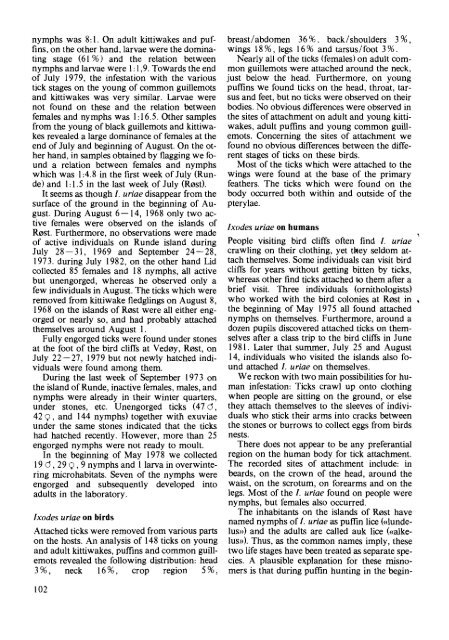Full-text - Norsk entomologisk forening
Full-text - Norsk entomologisk forening
Full-text - Norsk entomologisk forening
- No tags were found...
Create successful ePaper yourself
Turn your PDF publications into a flip-book with our unique Google optimized e-Paper software.
nymphs was 8: I. On adult kittiwakes and puffins,on the other hand, larvae were the dominatingstage (61 %) and the relation betweennymphs and larvae were I: 1,9. Towards the endof July 1979, the infestation with the varioustick stages on the young of common guillemotsand kittiwakes was very similar. Larvae werenot found on these and the relation betweenfemales and nymphs was I: 16.5. Other samplesfrom the young of black guillemots and kittiwakesrevealed a large dominance of females at theend of July and beginning of August. On the otherhand, in samples obtained by flagging we founda relation between females and nymphswhich was I:4.8 in the first week of July (Runde)and I: 1.5 in the last week of July (R0St).It seems as though l. uriae disappear from thesurface of the ground in the beginning of August.During August 6-14, 1968 only two activefemales were observed on the islands ofR0St. Furthermore, no observations were madeof active individuals on Runde island duringJuly 28-31, 1969 and September 24-28,1973. during July 1982, on the other hand Lidcollected 85 females and 18 nymphs, all activebut unengorged, whereas he observed only afew individuals in August. The ticks which wereremoved from kittiwake fledglings on August 8,1968 on the islands of R0St were all either engorgedor nearly so, and had probably attachedthemselves around August I.<strong>Full</strong>y engorged ticks were found under stonesat the foot of the bird cliffs at Ved0y, R0St, onJuly 22-27, 1979 but not newly hatched individualswere found among them.During the last week of September 1973 onthe island of Runde, inactive females, males, andnymphs were already in their winter quarters,under stones, etc. Unengorged ticks (47 d,42 Q, and 144 nymphs) together with exuviaeunder the same stones indicated that the tickshad hatched recently. However, more than 25engorged nymphs were not ready to moult.In the beginning of May 1978 we collected19 d, 29 Q, 9 nymphs and I larva in overwinteringmicrohabitats. Seven of the nymphs wereengorged and subsequently developed intoadults in the laboratory.Ixodes uriae on birdsAttached ticks were removed from various partson the hosts. An analysis of 148 ticks on youngand adult kittiwakes, puffins and common guillemotsrevealed the following distribution: head3%, neck 16%, crop region 5%,breast/abdomen 36 %. back/shoulders 3 %,wings 18 %, legs 16 % and tarsus/foot 3 % .Nearly all of the ticks (females) on adult commonguillemots were attached around the neck,just below the head. Furthermore, on youngpuffins we found ticks on the head, throat, tarsusand feet, but no ticks were observed on theirbodies. No obvious differences were observed inthe sites of attachment on adult and young kittiwakes,adult puffins and young common guillemots.Concerning the sites of attachment wefound no obvious differences between the differentstages of ticks on these birds.Most of the ticks which were attaChed to thewings were found at the base of the primaryfeathers. The ticks which were found on thebody occurred both within and outside of thepterylae.Ixodes uriae on humansPeople visiting bird cliffs often find l. uriaecrawling on their clothing, yet tkey seldom attachthemselves. Some individuals can visit birdcliffs for years without getting bitten by ticks,whereas other find ticks attached to them after abrief visit. Three individuals (ornithologists)who worked with the bird colonies at R0st in •the beginning of May 1975 all found attachednymphs on themselves. Furthermore, around adozen pupils discovered attached ticks on themselvesafter a class trip to the bird cliffs in June1981. Later that summer, July 25 and August14, individuals who visited the islands also foundattached l. uriae on themselves.We reckon with two main possibilities for humaninfestation: Ticks crawl up onto clothingwhen people are sitting on the ground, or elsethey attach themselves to the sleeves of individualswho stick their arms into cracks betweenthe stones or burrows to collect eggs from birdsnests.There does not appear to be any preferantialregion on the human body for tick attachment.The recorded sites of attachment include: inbeards, on the crown of the head, around thewaist, on the scrotum, on forearms and on thelegs. Most of the l. uriae found on people werenymphs, but females also occurred.The inhabitants on the islands of R0st havenamed nymphs of l. uriae as puffin lice (

















